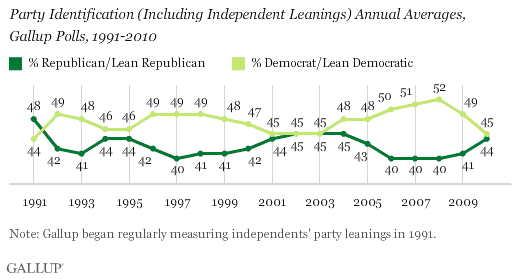PRINCETON, NJ -- In 2010, 31% of Americans identified as Democrats, down five percentage points from just two years ago and tied for the lowest annual average Gallup has measured in the last 22 years. While Democrats still outnumber Republicans by two points, the percentage identifying as independents increased to 38%, on the high end of what Gallup has measured in the last two decades.

These results are based on aggregated data from 21 separate Gallup and USA Today/Gallup polls conducted in 2010, encompassing more than 25,000 interviews with U.S. adults. Gallup has computed annual averages for party identification since 1988, when it began conducting most of its polls by telephone.
The Gallup Daily tracking poll, initiated in 2008, shows similar party identification figures for 2010 -- 32% Democratic, 28% Republican, and 37% independent. The tracking data also show the same trend toward declining Democratic identification coupled with greater increases among independents than Republicans.
While there is usually some year-to-year variation in party identification at the aggregate level, the changes are typically not large. Thus, the five-point drop in Democratic identification over the past two years, from the party's 22-year high of 36% (tying the 1988 figure) to its 22-year low of 31%, is notable.
Perhaps equally significant is that the percentage of Americans identifying as Republicans has increased only slightly to 29% during this time, and remains on the low end of what Gallup has measured the past two decades.
Nevertheless, 2010 was a good year for Republicans, given the party's major gains in the midterm elections. Those gains were in part driven by the party's appeal to independents, evident in the strong support for Republican congressional candidates among independent voters.
Independents' increasing affinity for the GOP is also evident in a separate measure of party affiliation Gallup tracks, which takes into account the party leanings of independents. In 2010, 45% of Americans identified as Democrats or said they were independent but leaned toward the Democratic Party, while 44% identified as Republicans or said they were independent but leaned Republican. The 1-point Democratic advantage is the party's smallest since 2003, when the parties were even, and represents a sharp decline from the record 12-point Democratic advantage in 2008.

The Gallup Daily tracking poll shows a similar pattern, from a 13-point Democratic edge in 2008 down to just 3 points in 2010.
Implications
Although 2010 brought some major legislative successes for the Democratic majority, it was not a good year for the party politically. In addition to losing control of the House of Representatives and seeing the number of Democratic senators and governors reduced, the party saw its support among the general population drop to tie its 22-year low.
However, even as Republicans were enjoying great electoral success, the percentage of Americans identifying with the GOP, the core base of the party, barely increased. Instead, the major movement in American politics since 2008 seems to be away from the Democratic Party and toward independent political status, rather than alignment with the GOP. Still, the Republican Party appeared to capitalize on many independents' frustration with the majority Democratic Party, in much the same way the Democrats capitalized on independents' frustration with the Republicans between 2006 and 2008.
As 2011 begins, the parties appear to be on fairly equal footing in terms of public support. The key to success in the 2012 elections may hinge on which party can win over the increasing number of independent voters. And it is quite possible that the pool of independents will expand in 2011, given that Gallup has seen an increase in the percentage of independents in each of the last five years after a midterm election (1991, 1995, 1999, 2003, and 2007).
Survey Methods
Results are based on aggregated data from telephone interviews conducted in 2010, with a random sample of 25,396 adults, aged 18 and older, living in the continental U.S., selected using random-digit-dial sampling.
For results based on the total sample of national adults, one can say with 95% confidence that the maximum margin of sampling error is ±1 percentage point.
Interviews are conducted with respondents on landline telephones and cellular phones, with interviews conducted in Spanish for respondents who are primarily Spanish-speaking. Each daily sample includes a minimum quota of 150 cell phone respondents and 850 landline respondents, with additional minimum quotas among landline respondents for gender within region. Landline respondents are chosen at random within each household on the basis of which member had the most recent birthday.
Samples are weighted by gender, age, race, Hispanic ethnicity, education, region, adults in the household, cell phone-only status, cell phone-mostly status, and phone lines. Demographic weighting targets are based on the March 2009 Current Population Survey figures for the aged 18 and older non-institutionalized population living in U.S. telephone households. All reported margins of sampling error include the computed design effects for weighting and sample design.
In addition to sampling error, question wording and practical difficulties in conducting surveys can introduce error or bias into the findings of public opinion polls.
For more details on Gallup's polling methodology, visit www.gallup.com.
